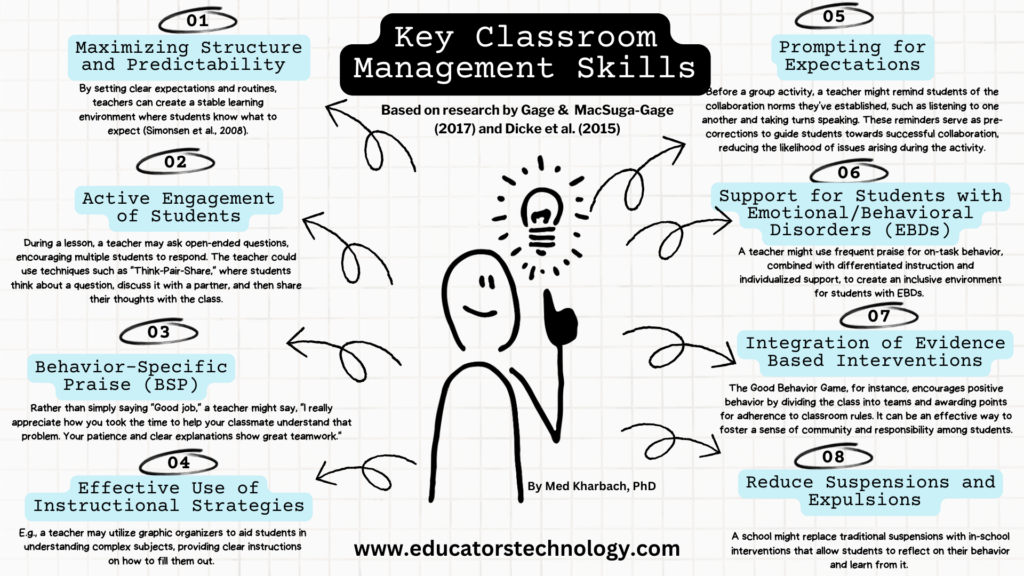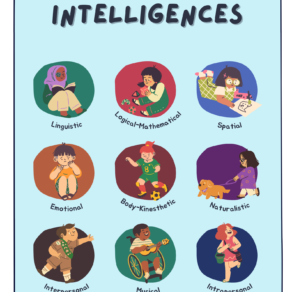Classroom Management Annotated Bibliography is the topic of our blog post today!
This post is part of a series dedicated to uncovering and understanding the multifaceted aspects of classroom management, an area pivotal to successful teaching and learning. In previous posts, we covered the classroom management skills, classroom management strategies, and we took a literary tour of some indispensable classroom management books. Now, we turn our attention to academic research, shedding light on the theories, practices, and insights that shape our understanding of managing a classroom.
The research world has been bustling with studies and articles that unpack classroom management from various angles. In this segment, we’re diving into these scholarly pursuits, ranging from inclusive settings to the foundational principles of a well-managed classroom. Drawing from both cutting-edge studies and time-honored research, we’ll weave together a tapestry of knowledge that offers practical, research-backed strategies.

Curran, M. E. (2003). Linguistic Diversity and Classroom Management.
- Summary: Curran emphasizes the growing need for U.S. teachers to work with English language learners (ELLs), focusing on understanding their perspective, utilizing pedagogical strategies, and promoting a classroom climate that embraces linguistic diversity.
- Commentary: This paper provides crucial insights into managing linguistically diverse classrooms. It’s refreshing to see a focus on empathy and strategic educational tactics. However, the paper might have benefited from more concrete examples and real-world scenarios.
Evans, K., Lester, J., & Anfara, V. A. (2010). What Research Says: Classroom Management and Discipline.
- Summary: This article explores the unique developmental needs of young adolescents, highlighting the challenges and discipline issues in middle schools. It emphasizes the importance of understanding and addressing these needs and outlines comprehensive classroom management approaches specific to middle schools.
- Commentary: The paper serves as a necessary reminder of the transitional phase of adolescence and how it can be overlooked in educational planning. Although well-researched and insightful, the paper could have explored more in-depth the specific methods teachers can adopt to mitigate discipline problems, beyond generic approaches.
Garrett, T. (2008). Student-Centered and Teacher-Centered Classroom Management.
- Summary: This case study analyzes the classroom management beliefs and practices of three teachers, focusing on student-centered versus teacher-centered approaches. The study found mixed results, with two teachers leaning towards student-centered management and one teacher-centered, reflecting principles from traditional classroom management studies.
- Commentary: This study’s focus on real-world, practical applications of both student-centered and teacher-centered management is commendable. However, the limited sample size may not fully represent broader teaching practices, and the conclusions could have been enriched with more detailed analysis of the teachers’ day-to-day strategies.
Gordon, D. G. (2001). Classroom Management Problems and Solutions: A few basic guidelines for classroom management can improve student behavior and reduce stress on the music educator.
- Summary: Gordon discusses the unique challenges of managing K-12 music classrooms, emphasizing the differences in approach needed due to the collective nature of music education, larger class sizes, and public performance pressures. The article suggests specialized discipline strategies for music educators.
- Commentary: This article presents a valuable perspective on the unique demands of music education. It sheds light on aspects often overlooked in general classroom management discussions. However, some practical, real-world solutions might have made the suggestions more actionable for music educators.
Jones, K. A., Jones, J. L., & Vermette, P. J. (2013). Exploring the Complexity of Classroom Management: 8 Components of Managing a Highly Productive, Safe, and Respectful Urban Environment.
- Summary: This piece examines the complexities of managing urban classrooms, outlining eight components including student-teacher relationships, high expectations, non-verbal cues, teacher consistency, perseverance, utilizing human resources, restorative justice, and school-wide consistency.
- Commentary: This paper offers an innovative and contextually relevant approach to urban classroom management. By focusing on various essential components, it embraces the multifaceted nature of classroom management. While strong in theory, the article might benefit from more empirical evidence or case studies to support these ideas.
KOUNIN, J. S., & Gump, P. V. (1958). The Ripple Effect in Discipline.
- Summary: This research study focuses on the “ripple effect” in discipline, examining how disciplinary measures affect not just the targeted child but also those observing. Conducted in twenty-six representative Detroit schools, the study analyses 406 incidents where a student watches another being corrected.
- Commentary: This study intriguingly examines an aspect of discipline that’s often neglected – the influence of disciplinary actions on observing students. Its observational methodology is a unique approach that provides valuable insights. However, the paper might be seen as dated, and its findings could be contextualized with current teaching practices and societal norms for a comprehensive understanding.
Macsuga-Gage, A. S., Simonsen, B., & Briere, D. E. (2012). Effective Teaching Practices: Effective Teaching Practices that Promote a Positive Classroom Environment.
- Summary: This article emphasizes the implementation of observable and measurable practices that cover academic instruction, behavior management, and relationship building. The key elements are consistency, communication, and structure, and the teachers’ continuous adaptation and reflection through professional development.
- Commentary: A great point from this paper is the focus on universal elements that form a strong classroom foundation. In my own teaching, I’ve found the emphasis on consistency and communication crucial. However, more specific examples and case studies could have brought the principles to life for educators looking for tangible ideas.
Malmgren, K. W., Trezek, B. J., & Paul, P. V. (2005). Models of Classroom Management as Applied to the Secondary Classroom.
- Summary: Addressing the challenges of behavior management in secondary classrooms, this article explores three models: Assertive Discipline, Logical Consequences, and Teacher Effectiveness Training. It gives examples of how each model might be applied to secondary education.
- Commentary: The article’s focus on different philosophies for classroom management provides readers with various lenses through which to view their practice. However, while valuable, these models might require tailoring to specific contexts and cultures within the classroom. The diverse experiences of students today may necessitate a more personalized approach.
Martin, N. K., Schafer, N. J., McClowry, S., Emmer, E. T., Brekelmans, M., Mainhard, T., & Wubbels, T. (2016). Expanding the Definition of Classroom Management: Recurring Themes and New Conceptualizations.
- Summary: This essay seeks to deepen our understanding of classroom management by exploring five evidence-based approaches: teacher self-regulation, relationships, temperament, belief systems, and community knowledge. It also highlights the implications for teacher preparation and future research.
- Commentary: I was particularly drawn to the complexity of classroom management portrayed in this essay. It resonates with my belief that classroom management is an intricate tapestry of interacting components. It’s refreshing to see an approach that recognizes the nuances of the teacher-student relationship and the dynamics of the classroom community. However, a deeper dive into how these interrelated approaches could be practically applied would have been beneficial for practitioners like me.
McGlyn, K., & Kelly, J. (2018). Engineering a classroom that works for all: Classroom management tips for students with learning differences.
- Summary: The authors emphasize the importance of identifying and adopting management strategies that cater to students with various needs, including learning disabilities, ADD/ADHD, speech/language impairments, autism, EBDs, and ELLs. They offer research-based strategies to create a positive and efficient learning environment.
- Commentary: This paper resonates with my experience in inclusive education. It stresses that a classroom must be designed with all students in mind. What’s compelling here is the recognition of the diverse needs that students bring to the classroom. I have personally found success in implementing flexible strategies that recognize individual needs while fostering a cohesive classroom community. I believe that teachers should strive for a blend of differentiated instruction and universal design.
Pedota, P. (2007). Strategies for Effective Classroom Management in the Secondary Setting.
- Summary: This article offers working strategies to help both new and veteran teachers with classroom management. It provides procedures that aim to maximize classroom instruction and incorporate effective classroom management techniques daily.
- Commentary: I found this article to be an excellent resource for teachers at various stages of their career. What stands out is the actionable advice it provides, making it a practical guide for enhancing discipline and respect in the classroom. However, I would have loved to see more in-depth case studies, focusing on real-life applications in various secondary school settings.
Reese, J. (2007). The Four Cs of Successful Classroom Management.
- Summary: This article introduces the “Four Cs” of classroom management: commendation, communication, consistency, and content. These principles aim to create a safe and fun environment, especially in elementary schools, focusing on nurturing positive experiences in music learning.
- Commentary: As someone passionate about integrating various subjects and arts into the curriculum, this article speaks volumes to me. The Four Cs are not only applicable to music education but can be seen as universal principles. The struggle of managing a class over making music is something I’ve heard from fellow educators, and I feel this approach offers a refreshing perspective. The focus on prevention over intervention aligns with my belief in creating a proactive classroom environment. However, I’d like to see how these principles could be adapted to other subject areas and educational levels.
Soodak, L. C. (2003). Classroom Management in Inclusive Settings.
- Summary: This paper discusses the opportunities and challenges of including children with disabilities in general education classes. It emphasizes community-building management strategies that facilitate friendships, collaboration, and parent involvement, and it underscores the need to address policies that are inconsistent with inclusive education.
- Commentary: Inclusion is at the heart of modern education, and Soodak’s work gives practical insights into managing a truly inclusive classroom. The concept of community-building management strategies connects deeply with my philosophy of fostering collaboration and positive relationships. From my own experience, I can vouch for the effectiveness of proactive measures, especially when working with children with diverse needs. However, the article could have benefited from concrete examples and templates that teachers can immediately apply in their classrooms.
Wong, H., Wong, R., Rogers, K., & Brooks, A. (2012). Managing Your Classroom for Success.
- Summary: The authors assert that classroom management is the cornerstone of a successful school year. They emphasize the importance of organizing and structuring classroom events for student learning, particularly during the first two weeks of school. The article highlights consistency and predictability as vital gifts that teachers can give to their students.
- Commentary: Having spent many years in the classroom, I strongly agree with the notions presented in this article. Those first two weeks of the school year set the tone, and I’ve always found that investing time in establishing clear procedures pays off in the long run. I particularly appreciate the article’s focus on the broader spectrum of classroom management, encompassing organization, structure, time, and materials. This aligns with my belief that classroom management is not merely about discipline but about creating an environment where learning can thrive. An extension of this work could involve case studies showcasing how different teachers implemented these strategies across various grade levels.
Concluding thoughts
As we conclude this curated exploration of research articles on classroom management, it’s evident that there’s a rich tapestry of insights to draw from. These studies form not just a theoretical foundation but provide practical, applicable strategies that resonate with our daily challenges and opportunities in the classroom.
From my own experiences, coupled with the wisdom distilled in these articles, it’s apparent that effective classroom management isn’t merely a set of rules but an evolving, dynamic practice that molds itself to the needs and potentials of our students. Whether you’re a fellow educator or a curious parent, I hope you found value in these perspectives, and I encourage you to apply, reflect, and innovate.






